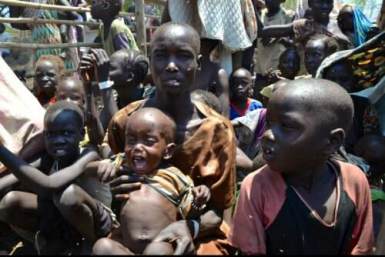Aid agencies working to improve conditions for S. Sudan refugees in Ethiopia
By Tesfa-Alem Tekle
May 19, 2014 (ADDIS ABABA) – The UN agency for refugees (UNHCR) said that it is working with its partners to improve camp conditions for tens and thousands of South Sudanese refugees who are being sheltered at camps in Ethiopia.

Spokesperson Adrian Edwards said UNHCR and its partners were rapidly scaling up their responses to meet the surge in new arrivals earlier this month.
Accordingly, refugees are now receiving improved access to nutrition, medical care and clean water, as well as health, sanitation and hygiene services.
The UN refugee agency is also building new camps as the influx of people fleeing violence continues to increase, while plans are underway to relocate refugees to higher ground as the rainy season approaches.
As many as 1,000 refugees have streamed in to Ethiopia in recent days despite a renewed ceasefire agreement signed last week by South Sudan’s rival leaders.
Most of them enter via Pagak and Akobo in the Western Gambella region bordering South Sudan.
The South Sudanese refugees are currently being accommodated in four camps, including Kule, Lietchuor, Pugnido and Okugo.
UNHCR and Ethiopia’s Administration for Refugees and Returnees Affairs (ARRA) have begun clearing areas around Kule camp which is approaching capacity, with a new camp being set up for another 30,000 people.
FOOD DISTRIBUTION
Aid agencies have launched a nutrition service at the border town of Burbiey, as well as a supplementary feeding programme centre with support from Norwegian Refugee Council (NRC).
Burbiey has recently experienced a sharp spike in new arrivals following escalating violence in Upper Nile state’s Longechuk, Nassir and Ulang areas a few weeks ago.
Mid-upper-arm circumference (MUAC) screening results indicate an an acute malnutrition rate of 25.12% and a severe acute malnutrition rate of 7.04% among the new arrivals to Burbiey.
According to a recent UNHCR report, food agencies have so far reached about 788,800 people as part of an emergency operation.
Food assistance has also been provided to a further 534,300 food-insecure people, including refugees and internally displaced people, in areas not directly affected by the conflict.
Airdrops were also conducted in Unity state’s Ganyel, Jonglei state’s Lankien and
Motot and other locations in Upper Nile state, although transportation and logistics remain a major challenge to aid agencies.
SANITATION AND HYGIENE
In Ethiopia’s Leitchuor camp, several communal latrines have been constructed, increasing the total number to 600, thereby reducing the ratio of latrines per person to 1:78 as compared to 1:113 a week ago.
In Kule camp, where there are more than 25,000 refugees, the user to latrine ratio stands at 1:149, with further water and sanitation facilities now under construction.
In Burbiey town, Médecins Sans Frontières (MSF) is constructing an additional 40 latrines on top of the 20 latrines that have already been completed, while the Danish Refugee Council (DRC) is trucking 65,000 litres of water per day.
It also is preparing materials for the construction of latrines and platforms for water treatment equipment.
HEALTH MEASURES
An immunisation campaign for measles and polio is currently being conducted at all entry points, including Burbiey town.
The UNHCR said 64,522 children under the age of five have been vaccinated against measles since 5 May, while 42,682 children under 15 were vaccinated for polio.
An additional 30,755 people have also received Vitamin A, 1,586
received deworming treatment, and 235 people were vaccinated against
tetanus.
The UNHCR said that improvements to health care had seen the mortality rate in Leitchuor camp among children under five drop from 0.8 per 10,000 people per day to
0.3 per 10,000 per day.
A cholera vaccination campaign is also underway following outbreaks of the highly infectious disease in the South Sudan capital, Juba, and other areas.
UN CAMPS IN SOUTH SUDAN
As of 14 May, the number of civilians seeking protection inside the country’s 10 UN camps had reached 79,249, including 32,000 in Juba and more than 47,000 at sites in Malakal, Bor, Bentiu, Wau, Melut, Renk, Nassir, Pariang and in Rumbek.
UNHCR said humanitarian situation on the ground continued to deteriorate, placing an enormous strain on already limited resources.
The agency has revised its 2014 funding requirements to $427 million, needed to provide humanitarian assistance in South Sudan and support its supplementary activities in Ethiopia, Kenya, Sudan and Uganda.
(ST)
